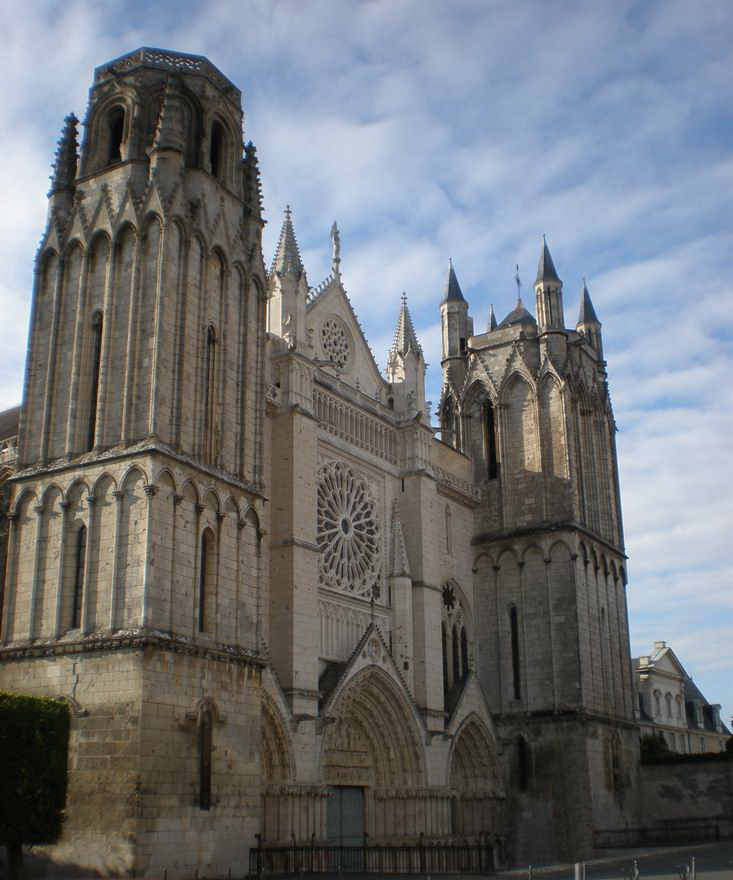This article features the organ in the Cathedral of Poitiers stamp from France in 1994. In 1787, François-Henri Clicquot, one of the greatest French organ builders was given a contract to build an organ for the cathedral. Before he could complete the instrument, he died in 1790, leaving his son to finish the work. The instrument made its formal debut in March of 1791. Two hundred years later, Jean-Loup Boisseau and Bertrand Cattiaux, were responsible for the cleaning and renovation of the instrument.
Organs on Stamps
Pipe organs are among the most prevalent specific instruments that appear on stamps. In other words, while other stamps might feature a generic violin, a generic guitar, or a generic piano, stamps with organs feature very specific instruments. Organs are usually very large and expensive and custom built for a specific church or cathedral. Large pipe organs can even be in use for several centuries (with regular maintenance and restoration work). Organs can become elements of pride for a parish, a community, or even a country.
You can read other posts about organs on stamps from Hamburg, Germany; Wasquehal, France; Geraardsbergen, Belgium; and from the Vatican City.
The Cathedral in Poitiers

De ArnoLagrange – Trabajo propio, CC BY-SA 3.0
The cathedral of Saint-Pierre stands on the site where there was previously a Roman basilica. Construction of the Christian church began in 1162 with the support of Henry II (Henry Plantagenet) of England and his wife Eleanor of Aquitane. Henry was also the Duke of Normandy and Aquitane, controlling at one point the entire western half of France. The cathedral was only consecrated in 1379.
The Saint-Pierre cathedral is primarily an example of the Romanesque architectural style. It has a central nave with two aisles that are nearly the same height and width. Unusually for the time, there is no apse. Also, it is one of the few cathedrals of the time without flying buttresses. The cathedral has two unfinished towers, which gives it a rather squat and heavy external appearance. The exterior sculpture is exquisite, including an illustration of the Last Judgment on three floors executed in high relief.
Most famously, the cathedral has important and extremely early stained-glass windows, some of which date from the twelfth century. The patrons of Henry II and Eleanor of Aquitane even appear in a large window that also features scenes of the Crucifixion.
The Organ
You can watch a video tour of the instrument on the following video:
Remarkably, the cathedral probably was home to an organ by 1363. A larger organ, perhaps from the fifteenth century, was destroyed in a fire in 1562. The organ builder Crespin Carlier installed an instrument in the cathedral in 1611, but it too was consumed in a fire on Christmas night of 1681.
It would take until the 1770s and 80s before a serious effort was made to replace the instrument. At that point, François-Henri Clicquot was commissioned to build a grand instrument appropriate for the majestic cathedral. The instrument has four keyboard manuals as well as a pedal board and more than 3,000 pipes.
Amazingly, the instrument has survived to the present day, although it has had several campaigns of restoration, most recently in the 1990s.
Stop List
| Great Organ | Positive | Récit | Echo | Pedal |
| Montre 16 ‘ | Montre 8 ‘ | Flute 8 ‘ | Bourdon 8 ‘ | Flute 16 ‘bouchée |
| Bourdon 16′ | Bourdon 8′ | Trumpet 8′ | Flute 8′ | Flute 8′ |
| Montre 8′ | Dessus de Flute | Hautbois 8′ | Trumpet 8′ | Flute 4′ |
| Second 8′ | Prestant 4′ | Cornet V | Bombard 16′ | |
| Bourdon 8′ | Nazard 2′ 2/3 | Trumpet 8′ | ||
| Prestant 4′ | Doublette 2′ | Clairon 4′ | ||
| Grand third 3′ 1/5 | Tierce 1′ 3/5 | |||
| Nazard 2′ 2/3 | Plein-jeu VII | |||
| Doublette 2′ | Cornet V | |||
| Quarter nazard 2′ | Trumpet 8′ | |||
| Third 1 ‘3/5 | Clairon 4′ | |||
| Fourniture V | Cromorne 8′ | |||
| Cymbal IV | ||||
| Grand V cornet | ||||
| 1st Trumpet 8′ | ||||
| 2nd Trumpet 8′ | ||||
| 1st Clairon 4′ | ||||
| 2nd Clairon 4′ | ||||
| Voix humaine 8′ |
Read more about the organ at this blog post.
The Stamp

Scott Number FR 2433
The stamp commemorates the restoration of the instrument and it was issued on July 2, 1994. The multicolor postage stamp features a beautifully executed black and white engraving of the case of the Clicquot organ. Above and behind the trumpeter crowning the top of the case can be seen a stained-glass window, on the stamp glowing in a shade of purple. Around the case of the organ, the stone of the church itself has an orangish-brown tint. The design for the stamp was by the engraver P. Lubin.
Finally, take a moment to listen to the sound of this magnificent pipe organ below:


